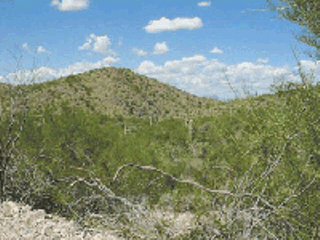Gayle Hartmann, the local archaeologist who's spent countless hours working on Pima County preservation issues, points out the jagged dirt road jutting across the east side of Twin Hills, a pair of low peaks west of Tumamoc Hill. We're driving down Sixth Street past the University of Arizona, still miles away from the mountain, and the road is already visible, a brown slash desecrating yet another hilltop in the Tucson Mountains.
A developer is putting 14 houses on the two hills. The project is a done deal; there's nothing the Pima County Board of Supervisors can do about it now.
The land that Hartmann wants to talk about today is roughly 186 acres of virgin desert across the street from Twin Hills. A few clicks west of Greasewood Park, the cactus-covered parcel separates Anklam Road from Speedway Boulevard.
The property, zoned for one house per acre, is owned by the Sherman Trust, whose representatives have proposed building 67 homes, much to Hartmann's dismay.
"It's part of a scenic gateway on the western side of community," Hartmann says. "Everybody who goes to the Desert Museum passes through that area and perceives that they are now out in protected Sonoran Desert. I think it will be a real shock to people, and it's one more way that community views are deteriorating around the edges, when we have a beautiful, saguaro-covered hill like that, and it starts getting covered with houses."
The developers filed their plan with the county this summer, but it was rejected because of some technical issues related to the topography and the length of a proposed cul-de-sac, according to Fran Dostillio, with the county's Development Services Department. But those details are hardly a deal-breaker; the developer can address the problems with a revised plan.
County officials had planned to purchase the patch of desert with open-space bond funds passed by voters in 1997. Roughly $1.8 million was set aside for the parcel, but Hartmann suspects that's a lowball estimate, given that six years has passed since the bond package passed, and now the property owners stand to make more money by developing the land.
Regardless of the price, bond money has run short. About $7 million remains from the 1997 package, but that money has been informally set aside to buy land in the Tortolita Mountains. There, the county hopes to takes advantage of the state's Arizona Preserve Initiative, which would provide another $7 million in state matching funds, doubling the county's money.
Hartmann agrees that the maneuver makes fiscal sense, especially since the county has already spent nearly $12 million expanding Tucson Mountain Park by some 1,600 acres on the south side of Ajo Way.
But she still wishes there was some way to rescue this patch before the bulldozers lurch into gear. Without fast action from the Board of Supervisors, that's not likely to happen.
Supervisor Richard Elias, the Democrat who represents the area, couldn't be reached for comment.
The pending development along Anklam is yet another chapter in the ongoing saga of urban sprawl in the Tucson Mountains, where more and more houses are now popping up on ridges. One ham radio aficionado has even erected a 99-foot-tall antenna atop one hill, much to the dismay of surrounding neighbors.
"I'm disappointed," says Roger Carpenter, a former president of the Gates Pass Area Neighborhood Association. "I really object to the zeal with which people who want to build on ridge tops. In the last year, the most vigorous development has been going in on ridge tops."
Carpenter says the pace of development has picked up dramatically in the last four years. From his house, he can see close to 50 homes either newly built or under construction.
"I don't understand the reason for it, but the process for identifying peaks and ridges for protection has been horribly slowed down," says Carpenter, a retired college professor who has lived in the area for nine years. "Yet the landowners know this is coming, so there's there a big rush to get development started on individual properties in order to beat whatever approval the county's ever going to give to some ridge protection."
Near Gates Pass, which features one of the most spectacular views in suburban Pima County, new homes are regularly popping up. The north side of the road leading to the pass is covered in houses; the southern side, which had been undeveloped, is starting to fill up as well.
Carpenter points to the area around Camino del Oeste, the road near Gates Pass that leads to the head of the Yetman Trail crisscrossing Tucson Mountain Park. On the east side of the street, houses are tucked across the landscape, but the west side is still mostly undeveloped, although a few homes have started to pop up.
The land, owned in small patches by individual owners, was part of the 1997 bond package as well, but the money is nearly gone. If the county doesn't soon find a way to buy the property, Carpenter fears a new batch of homes will soon dot the landscape.
"This is not a neighborhood issue alone," says Carpenter. "The development in this area is going to affect everybody who goes to Tucson Mountain Park or the Desert Museum, because the most popular route out here is out West Speedway or Anklam Road and over Gates Pass--and that's where the really egregious development is occurring."
















